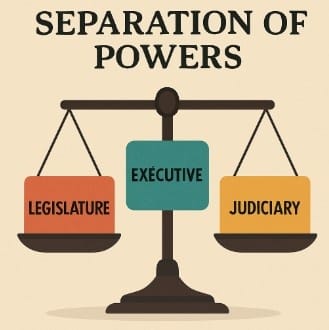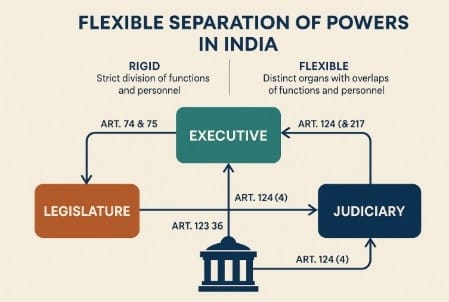
What is Separation of Powers? Origin and Theory
“Power tends to corrupt, and absolute power corrupts absolutely.” — Lord Acton
Separation of Powers sets out that the State derives its power from several organs—Legislature, Executive, and Judiciary—to avoid concentrating power and to introduce checks and balances. It aims to introduce fairness and accountability and the rule of law, so that one organ cannot be supreme in law or argument.
The French philosopher Montesquieu in his seminal work Spirit of Laws gave the doctrine of Separation of powers.
The Doctrine of Separation of Powers provides for three major aspects:
- Establish three organs of the state namely Legislature, executive, and judiciary;
- Define their powers and functions;
- No person shall be a member of more than one organ.
Origin of the Theory
Ideas of separation of powers can be traced back to Ancient Greece, where philosophers advocated the dangers of concentration of power due to authority:
- Aristotle: Acknowledges three elements of government in Politics—the deliberative (making law), magisterial (executing law) and the judicial (interpreting law).
- Plato: Agrued the state should be structured with class (function), so no concentration of power could arise as each social class could attend to their respective tasks in a structured state.
- Polybius: In The Histories, Polybius praises the Roman Republic for its balance of monarchy (consuls), aristocracy (Senate), and democracy (popular assemblies), representing a balanced – even mixture – of authority; which was one of the first to resemble a mixed government.
The Separation of Powers in India
Professor KT Shah suggested an amendment which is Article 40-A to the Constitution, calling for complete separation of the legislature, executive, and judiciary in India. In India, separation of powers does not exist in the form of those used in the USA. India follows a system that involves balanced division of powers with interdependence among branches:
- Legislature – makes laws (Parliament at the Central level, State Legislatures at the State level).
- Executive – enforces laws (President, Prime Minister, Council of Ministers, Civil service).
- Judiciary – judges the constitutionality of the law (Supreme Court, High Courts, lower Courts).
SEPARATION OF POWERS- CONSTITUTIONAL PROVISIONS
Article 105
(it is for the Union while Article 194 is for the State with similar provisions):
Anything said on the floor of the house or any vote given shall not be called into question in any court. This immunity is extended to Parliamentary committees.
Article 121
(Article 211 for state)
The conduct of the judges of the Supreme Court and High Court shall not be discussed in the Parliament except while presenting a motion for their removal.
Article 122
(Article 212 for states)
The validity of the proceedings of the Parliament shall not be called into question on grounds of irregularity of procedure.
Article 50
The Article provides for the state to take steps to separate the Judiciary from the executive.
How India Implements a ‘Flexible’ Separation Model
India doesn’t have a rigid separation of powers like the USA or a total fusion of powers like the UK. Instead, it employs a “functional” or “flexible” separation model, where the Legislature, Executive, and Judiciary are distinct in theory but interdependent in practice.
This design is deliberate—ensuring that while powers are divided, cooperation between organs allows for efficient governance and prevents paralysis.
1. Nature of the Flexible Model
The Supreme Court in the Rattan Chandra Case states that, if the legislature fails to keep pace with the changing needs, therefore, it becomes obligatory for the judiciary to fill that void.
Functional overlaps are part of the Indian model, where each organ performs some non-core functions of others.
The system maintains balance, not absolute separation. The provisions related to functional overlap primarily exhibit the fact that separation of powers is not water-tight and in the practical sense, the Provisions ensure that every organ performs some non-core functions.
2. Real-World Examples of Overlaps
| Overlap Type | Example | Explanation |
|---|---|---|
| Judicial Activism | Kesavananda Bharati vs. State of Kerala (1973) | Judiciary laid down the Basic Structure Doctrine, indirectly restricting Parliament’s amending power. |
| Judicial Overreach | Striking down NJAC Act (2015) | Court nullified a constitutional amendment passed by Parliament, citing violation of judicial independence. |
| Executive in Legislature | Prime Minister and Ministers also being MPs | Ministers perform both law-making and law-executing roles. |
| Ordinance Power | Re-promulgation of ordinances by the Executive | The President/Governor issues ordinances (Art. 123 & 213) bypassing legislative debate. |
| Judicial Review of Executive Orders | Striking down Section 66A of IT Act (2015) | Judiciary nullified an executive-implemented law for violating free speech. |
While each organ checks the other under a checks and balances framework, none of the organs are in completely independent mode.
3. DOCTRINE OF CHECKS AND BALANCES
Checks and balances by different organs is also one of the main feature of Indian separation of power. Constitutionally as well as through various Landmark judgements these checks and balances have taken a physical form.
Landmark Supreme Court judgements-
- The Supreme Court in Ram Jawaya Case Ruled that the functions of various organs have been sufficiently differentiated but the separation of powers is not practised with absolute Rigidity.
- The Supreme Court in the Golaknath Case observed that the three organs of the state are expected to function within their respective domain and not encroach into each other’s domain.
Practical Checks
The doctrine of Checks and Balances promotes Constitutional Supremacy and prevents any organ from becoming too powerful.
- The Legislature keeps a check on the executive through no-confidence motions, question hours, etc.
- The executive recommends the prorogation and summoning of the sessions of the Parliament.
- The Parliament can pass a removal motion to remove the judges of the Supreme Court and High Court if they are involved in provided misbehavior or incapacity.
- The President exercising pardoning power under Article 72 or the Parliament impeaching the President under Article 61 is an example of functional overlap.
This Doctrine of Separation of Powers is of paramount significance because it avoids the concentration of powers and ensures that the liberal democratic character of the state is maintained. The Doctrine of Checks and Balances maintains the equilibrium and avoids usurping of power by any organ of the state.
4. Constitutional Provisions Showing Overlap
| Article / Provision | Nature of Overlap | Example |
|---|---|---|
| Art. 74 & 75 | Executive part of Legislature | PM & Ministers are MPs |
| Art. 123 | Executive makes law temporarily | President’s Ordinance-making power |
| Art. 124 & 217 | Executive appoints Judiciary | President appoints SC & HC judges |
| Art. 124(4) | Legislature can remove judges | Impeachment of SC/HC judges |
| Art. 50 | Separation of judiciary from executive (directive) | Implemented in lower judiciary reforms |
| Art. 72 & 161 | Executive overrides judicial punishment | Pardoning powers of President/Governor |
| Art. 13, 32, 226 | Judiciary strikes down laws | Kesavananda Bharati case |
| Art. 368 | Legislature amends Constitution | Parliament responding to judicial review |

Why Absolute Separation is Not Possible or Desirable in India
Nature of Parliamentary Systems
In the Westminster tradition, the executive grows from the legislature, ensuring overlap is inevitable. Ministers are made accountable to Parliament, ensuring Parliament can keep checks.
Efficiency in Governance
Cooperation can speed up the decision-making (e.g., the requirement for timely action in times of emergency) whereas
Rigid separation can lead to paralysis.
Checks and Balances as a Safety Valve
Overlap allows each organ of government to monitor and rectify each other. For example, judicial review prevents laws that are arbitrary or unfair while legislative oversight prevents abuses of power by the Executive.
The Indian Context and Urban Diversity
The country is marked by complex social, economic, and political realities requiring alternative forms of governance. Flexibility allows organs of government the ability to quickly address crises while still ensuring constitutionalism is observed.
Read about Constitutionalism as bedrock of polity
UPSC Questions Where This Understanding Is Crucial
Prelims Practice (PYQs)
- 2021 Prelims:
Q: Which one of the following factors constitutes the best safeguard of liberty in a liberal democracy?
(a) A committed judiciary
(b) Centralization of powers
(c) Elected government
(d) Separation of powers
Answer: Separation of powers – it minimizes arbitrary use of power through checks and balances. - Another Prelims Question:
India’s model differs from the British one because Parliament’s legislative power is limited and amendments’ constitutionality can be reviewed by the Supreme Court.
Mains Insight
- 2022 Mains: Discuss mechanisms that establish separation of powers and check parliamentary sovereignty in India .
- 2019 Mains: Does the Indian Constitution favor ‘checks and balances’ over rigid separation?
- Many UPSC Mains questions highlight how checks and balances help maintain constitutional equipoise (e.g., on judicial activism, ordinance power, prerogatives during emergencies)
Conclusion: Separation of Powers as a Functional Ideal, not a Dogmatic Principle
In India, separation of powers is not an indestructible impermeable wall between the Legislature and Executive and the Judiciary but a living principle to protect liberty from large concentrations of power, and promote effective governance. Therefore, the founding framers of the Constitution opted for the checks-and-balances model of governance as opposed to a strict separation model.
This flexibility means that governance is not rendered ineffective by the rigid compartmentalization of legislative, executive, and judicial functions of each branch of government, while at the same time checks and balances can keep the over-reach of power constrained by constitutional safeguards like judicial review, effective parliamentary oversight, and a vigorous press.
While there is overlap, this model constrains the primacy of each arm of government – making it pragmatic enough to support govenance which is flexible enough to adapt to problems faced by a country with India’s socio-political baggage.


Very helpful 👏